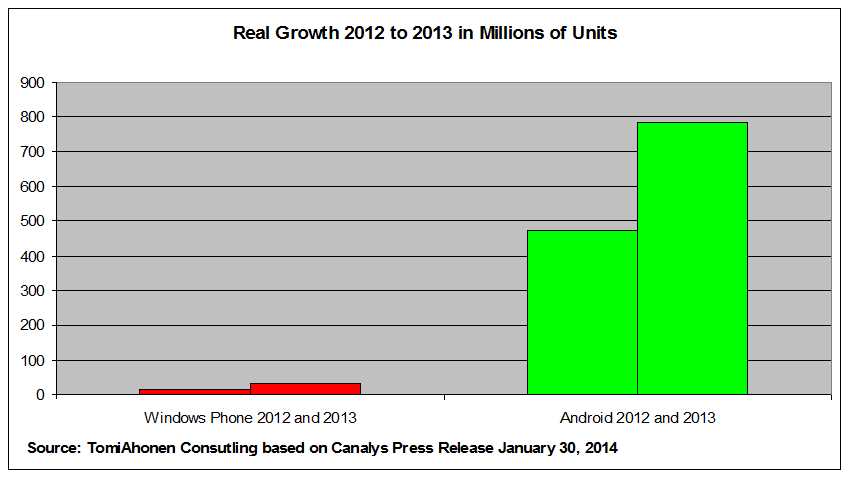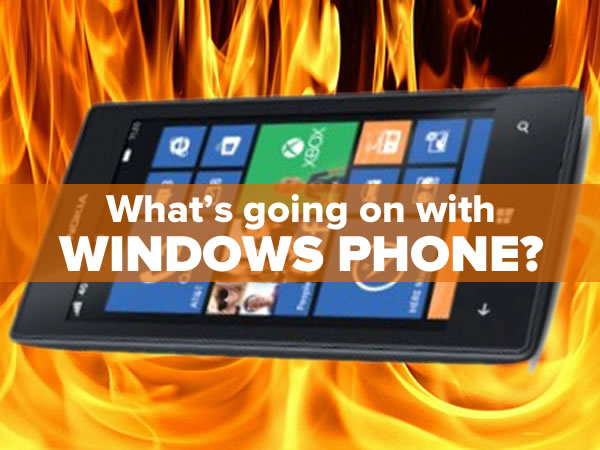
What’s going on with Windows Phone? Right now, not much market share and a whole lot of speculation. Read on, as we look over the history and recent stories of Microsoft’s current mobile operating system.
What’s going on with Windows Phone’s market share?
 Market share, by definition, is a zero-sum game: in order for a player to get more market share, it has to take it away from the other players. Microsoft played a very good zero-sum game in the 1990s, grabbing the lion’s share of a number of markets: desktop operating systems, business productivity software, the browser, and in the second quarter of 2007, half the smartphones sold in the US ran Windows Mobile.
Market share, by definition, is a zero-sum game: in order for a player to get more market share, it has to take it away from the other players. Microsoft played a very good zero-sum game in the 1990s, grabbing the lion’s share of a number of markets: desktop operating systems, business productivity software, the browser, and in the second quarter of 2007, half the smartphones sold in the US ran Windows Mobile.
The release of the iPhone redefined the smartphone market, not just in terms of market share, but also in terms of feature set and design. It forced Google to drastically alter their plans for Android, which at the time was more like the BlackBerry and Windows Mobile devices of that era, with a hardware keyboard, a directional pad, and a non-touch-sensitive screen (there’s a photo of a prototype on the right). By playing fast follower — something that used to be Microsoft’s stock in trade — Android grew, eventually claiming more than half the mobile OS market share in 2011.
Microsoft didn’t respond as quickly. In fact, then-CEO Steve Ballmer famously dismissed the iPhone, saying that it was yet another overpriced Apple device, and that the business market — where they make most of their money, and then the primary market for smartphones — wouldn’t go for it since it lacked the all-too-necessary hardware keyboard needed for real work. A year later, the Windows Mobile team was reorganized and put to work on what would become Windows Phone. In the meantime, the lackluster Windows Mobile 6.5 was put out as an interim release in 2009, when Ballmer publicly admitted that Microsoft had “screwed up with Windows Mobile”. Windows Phone, first introduced as “Windows Phone 7 Series” was released for the North American market in November 2010, almost three and a half years after the first iPhone. Sales were sluggish, and as I recall from my time at Microsoft (I was a Developer Evangelist and designated Windows Phone Champ), the carrier support was nearly non-existent. Months after Windows Phone’s release, Ballmer admitted that Windows Phone adoption was disappointing, with their share of the market having gone from “very small…to very small”.
Stephen Elop, former head of Microsoft’s business division (Office 2010 was released under his watch) left in 2010 to become Nokia’s CEO, and in February 2011, the Microsoft/Nokia alliance was announced. Some people believed that the bringing together of two giants would boost Windows Phone’s fortunes — IDC and Gartner predicted that Windows Phone would be the number two OS after Android by 2015, and Pyramid Research boldly (read: “crazily”) predicted that it would have seized the number one spot from Android by now. Others, like Googler (and ex-Microsoftie) Vic Gundotra didn’t see it that way; in response to the alliance, he tweeted:
#feb11 “Two turkeys do not make an Eagle”.
— vicgundotra (@vicgundotra) February 9, 2011
He turned out to be right.

Here’s a look at the mobile OS market as of the fourth quarter of 2013:
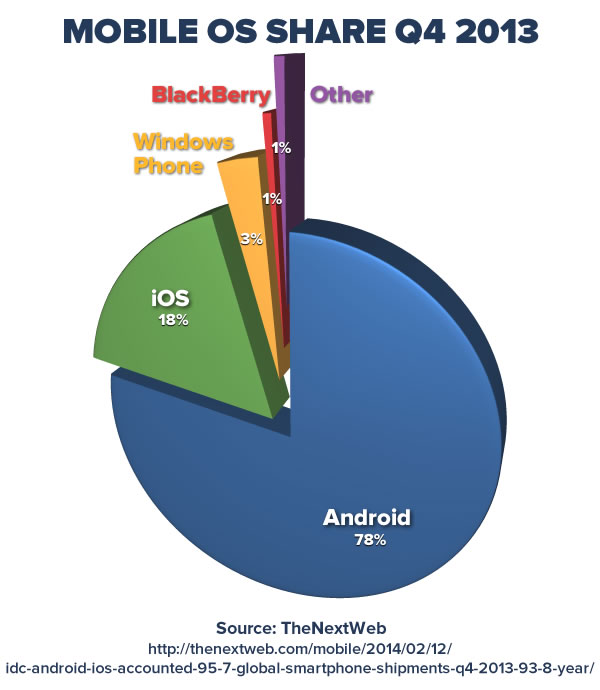
Last quarter, Android and iOS accounted for nearly 96% of all smartphone shipments. In the zero-sum game of mobile share, that leaves Microsoft with less than four percent of the market, less than the minimum double-digit share believed necessary to thrive, and certainly less than the 20% share predicted by Gartner and IDC, and the 40% share predicted by Pyramid Research. If Microsoft expect to remain a player in the mobile OS market, and if it intends to shift its focus to devices as services as put forth in its latest mantra, it will have to make radical changes to Windows Phone.
What about that Canalys story about Windows Phone being the fastest-growing mobile OS?
 A couple of weeks ago, we wrote about an announcement from industry analyst Canalys stating that Windows Phone is now the fastest-growing mobile platform, having experienced at 69% year-over-year increase in the fourth quarter of 2013. Tomi Ahonen, an avid Nokia-watcher and whom I think of as “the Grumpy Cat” of mobile industry punditry, is calling shenanigans on Canalys’ statistics, calling them “deliberately misleading and utterly untrustworthy”. He argues that Canalys is misleading people by talking about the growth rate rather growth, which makes the number of Windows Phone devices shipped look considerably more impressive. He says that if you compare growth rather than growth rate, Windows Phone’s performance looks very dismal:
A couple of weeks ago, we wrote about an announcement from industry analyst Canalys stating that Windows Phone is now the fastest-growing mobile platform, having experienced at 69% year-over-year increase in the fourth quarter of 2013. Tomi Ahonen, an avid Nokia-watcher and whom I think of as “the Grumpy Cat” of mobile industry punditry, is calling shenanigans on Canalys’ statistics, calling them “deliberately misleading and utterly untrustworthy”. He argues that Canalys is misleading people by talking about the growth rate rather growth, which makes the number of Windows Phone devices shipped look considerably more impressive. He says that if you compare growth rather than growth rate, Windows Phone’s performance looks very dismal:
Chart by Tomi Ahonen. Click to see at full size.
What’s going on with Windows Phone and Android?
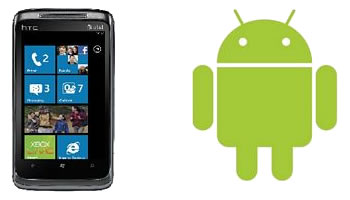 For now, the answer is “nothing yet, other than a lot of armchair quarterbacking and speculation.”
For now, the answer is “nothing yet, other than a lot of armchair quarterbacking and speculation.”
Last week, the Guardian’s tech writer, in one of those “advice to the CEO” opinion pieces that usually appears when a major company takes on a new chief, suggested that Microsoft scrap their current efforts with Windows Phone and create a “fork” of Android. “Forking”, if you’re not familiar with the term, is one of the two major options that open source software presents to a developer: you can either contribute to the effort, or you can fork it — as in “fork in the road” — by taking the code, going your own way, and working with your own version, with the features you want.
Ars Technica’s Peter Bright wrote a counter to the Guardian article, saying that Android, while nominally open source, is “unforkable”, because it has two major components:
- AOSP, the Android Open Source Platform, the “basic bones of a smartphone operating system”, which anyone can take and put on a mobile device. Amazon has done just that with their Kindle devices.
- GMS, Google Mobile Services, which provides “a wealth of APIs and system services”, including Google Maps, location, in-app purchasing, as well as a lot of the standard apps on Android devices, including Search, Gmail, Chrome, Maps, and so on. You can’t fork this, your device must pass Google approval to use GMS, and it costs an estimated $0.75 per device.
Bright argues that while you can create a fork of Android with AOSP, without GMS and all the goodies that come with it, it’s just not the Android that users know and love. Not only will the fork not have a lot of the standard Android apps that people expect, but many third-party apps that rely on APIs — Application Programming Interfaces, the “hooks” that programmers rely on to access specific features — provided by GMS; they just won’t work on an Android fork without GMS.

At Stratechery, one of the five points in Ben Thompson’s answer to the question “What should Microsoft do?” in terms of mobile is to fork Android. He suggests that Microsoft could build a mobile OS on top of AOSP (AOSP.NET, perhaps?) and then use its own services — Bing Search, Bing Maps, Outlook and so on — as replacements for the goodies that come with GMS. They could even make APIs that are really similar to those offered in GMS so that it would be easy for third-party developers to port their Android code to the Microsoft’s forked version.
Thompson’s plan calls for “Microsoft’s global platform evangelists to encourage every Android developer to change a few lines of code and submit to the Microsoft AOSP App Store”. There’s a big problem with this, and I say this with some authority as a former member of said global platform evangelists, and as one whose area of specialization was Windows Phone:
- It’s not going to win over Microsoft developers. Microsoft has a tendency to create a new technology, promote it madly to developers, then kill or abandon it after creating a newer, shinier technology. They feel that they’ve been jerked around enough, first with the complete incompatibility of Windows Phone 7 with Windows Mobile 6.5 and previous Windows Mobile OSs, and then with the big changes in development model from Windows Phone 7 to Windows Phone 8. Dropping Windows Phone and encouraging developers to learn building for Yet Another New Mobile Operating System will be the straw that broke the camel’s back.
- It’s not going to win over Android developers. They’ll see this as Microsoft reverting to its old strategy of “Embrace, Extend, and Extinguish”, and they’re not going to want to be party to that sort of history repeating itself.
The new Microsoft may embrace open standards such as HTML5 and JavaScript, but a whole operating system that they didn’t invent? For a company in the business is selling operating systems and office productivity software? Highly unlikely.
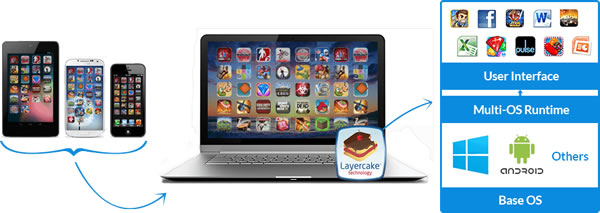
And finally, there’s talk of Microsoft considering letting Android apps run on not just Windows Phone, but even Windows — as in desktop/laptop/Surface Pro tablet Windows — as well. Running Android on Windows desktop has been possible for a while now, thanks to virtualization technologies like BlueStacks’, and it may be possible to port their virtualization technology to Windows Phone.
Mary Jo Foley says that such a fork would demotivate developers for the same reasons I cited above.
What do you think? Would you use a Windows Phone if it could run Android apps as well as an Android-only device?
